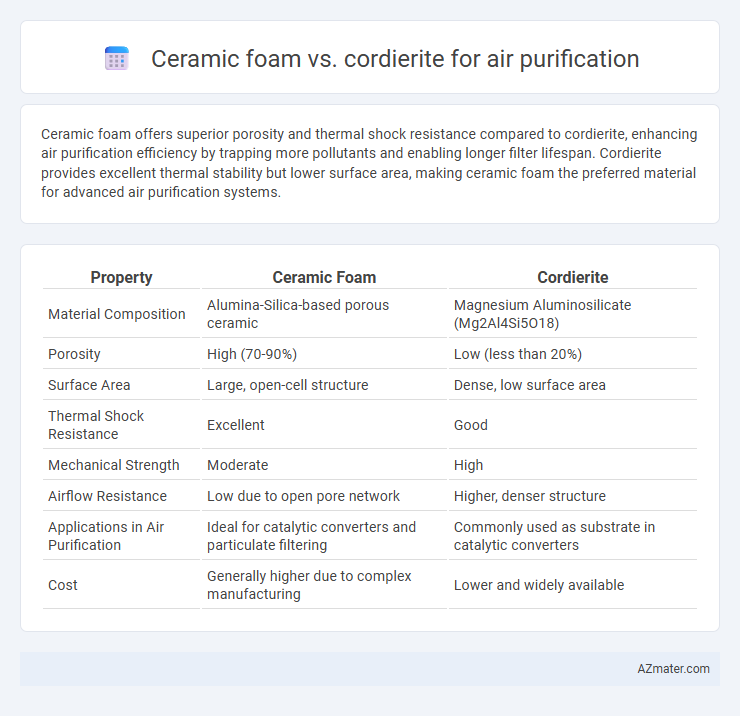Ceramic foam offers superior porosity and thermal shock resistance compared to cordierite, enhancing air purification efficiency by trapping more pollutants and enabling longer filter lifespan. Cordierite provides excellent thermal stability but lower surface area, making ceramic foam the preferred material for advanced air purification systems.
Table of Comparison
| Property | Ceramic Foam | Cordierite |
|---|---|---|
| Material Composition | Alumina-Silica-based porous ceramic | Magnesium Aluminosilicate (Mg2Al4Si5O18) |
| Porosity | High (70-90%) | Low (less than 20%) |
| Surface Area | Large, open-cell structure | Dense, low surface area |
| Thermal Shock Resistance | Excellent | Good |
| Mechanical Strength | Moderate | High |
| Airflow Resistance | Low due to open pore network | Higher, denser structure |
| Applications in Air Purification | Ideal for catalytic converters and particulate filtering | Commonly used as substrate in catalytic converters |
| Cost | Generally higher due to complex manufacturing | Lower and widely available |
Introduction to Air Purification Materials
Ceramic foam and cordierite are widely used materials in air purification due to their exceptional filtration and thermal properties. Ceramic foam offers high porosity and excellent catalytic support, enabling efficient removal of pollutants and particulate matter. Cordierite is prized for its thermal stability and resistance to thermal shock, making it ideal for catalytic converters and diesel particulate filters in air purification systems.
What is Ceramic Foam?
Ceramic foam is a porous, lightweight material made from alumina, silica, or zirconia, designed to maximize surface area for efficient air purification by trapping particulates and catalyzing chemical reactions. Its open-cell structure enhances airflow while providing high thermal stability and resistance to corrosion, making it ideal for filtering pollutants in industrial and automotive applications. Compared to cordierite, ceramic foam offers superior permeability and catalytic efficiency, improving the overall performance of air purification systems.
Understanding Cordierite: Properties and Uses
Cordierite is a crystalline mineral known for its excellent thermal stability, low thermal expansion, and high resistance to thermal shock, making it ideal for air purification applications where fluctuating temperatures occur. Its porous structure enables efficient filtration and adsorption of airborne contaminants, contributing to improved air quality in industrial and environmental settings. Commonly used in catalytic converters and filter substrates, cordierite's durability and chemical inertness ensure long-term performance in air purification systems.
Key Differences in Material Composition
Ceramic foam is composed primarily of alumina and silica, offering a porous structure with high thermal shock resistance and excellent catalytic support for air purification. Cordierite, a magnesium iron aluminum cyclosilicate, features low thermal expansion and superior thermal stability, making it ideal for temperature-resistant air filtration applications. The key difference lies in ceramic foam's highly porous, open-cell matrix that enhances pollutant capture, while cordierite provides structural durability and low thermal deformation under fluctuating temperatures.
Filtration Efficiency: Ceramic Foam vs Cordierite
Ceramic foam exhibits higher filtration efficiency compared to cordierite due to its porous structure and larger surface area, enabling superior particulate capture in air purification systems. Cordierite, while thermally stable, offers lower porosity, resulting in reduced filtration performance for fine particulates. The enhanced permeability and durability of ceramic foam make it a preferred choice for achieving optimal air filtration efficiency.
Durability and Thermal Stability Comparison
Ceramic foam exhibits superior thermal stability withstanding temperatures up to 1,300degC, making it highly durable for continuous air purification in harsh thermal environments. Cordierite offers good durability but has a lower thermal stability threshold around 1,000degC, which may limit its performance under extreme heat conditions. The enhanced porosity and fracture resistance of ceramic foam contribute to longer lifespan and consistent filtration efficiency compared to conventional cordierite substrates.
Cost Analysis: Which Material is More Economical?
Ceramic foam generally incurs higher initial costs due to its complex manufacturing process and superior porosity, which enhances air purification efficiency by trapping finer particulate matter. Cordierite, being more affordable and widely available, offers a cost-effective solution for large-scale applications but may require more frequent replacement or maintenance due to lower durability under thermal stress. Evaluating total lifecycle expenses, ceramic foam provides better long-term value in high-performance or industrial air purification, whereas cordierite suits budget-conscious projects with moderate efficiency needs.
Environmental Impact and Sustainability
Ceramic foam air purifiers significantly reduce emissions due to their high thermal stability and porous structure, which enhances pollutant breakdown efficiency and extends lifespan, thereby minimizing waste. Cordierite, while effective in thermal shock resistance, has a lower surface area that limits catalytic activity, potentially resulting in higher energy consumption and more frequent replacements. The sustainable advantage of ceramic foam lies in its longer durability and recyclability, making it a preferable choice for eco-friendly air purification systems aiming to reduce environmental footprints.
Application Suitability for Air Purification Systems
Ceramic foam exhibits superior porosity and thermal shock resistance, making it ideal for high-efficiency air purification systems in industrial environments requiring rapid temperature fluctuations. Cordierite, with its low thermal expansion and excellent chemical stability, is well-suited for catalytic converters and residential air filters where consistent performance under moderate conditions is essential. Application suitability depends on operational temperature ranges and chemical exposure; ceramic foam excels in harsh, variable environments, while cordierite offers durability and cost-effectiveness for standard air purification needs.
Conclusion: Choosing the Right Material for Air Purification
Ceramic foam offers superior porosity and durability, enhancing the filtration efficiency and lifespan in air purification systems compared to cordierite. Cordierite provides excellent thermal shock resistance and cost-effectiveness but lacks the high surface area of ceramic foam, limiting its capacity for pollutant adsorption. Selecting ceramic foam is ideal for advanced applications demanding high filtration performance, while cordierite suits processes prioritizing thermal resilience and budget constraints.

Infographic: Ceramic foam vs Cordierite for Air purification
 azmater.com
azmater.com